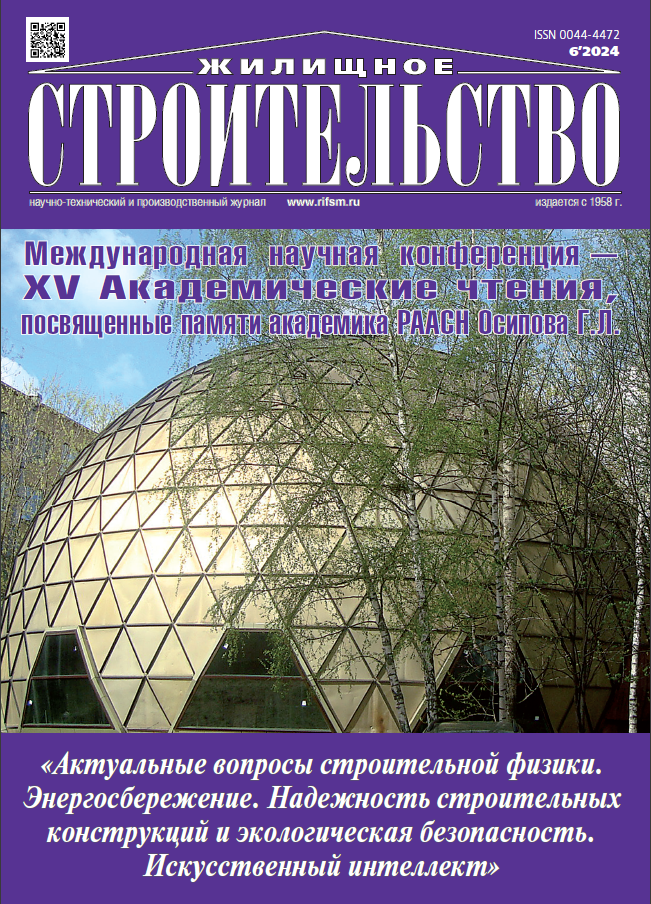Modelling the Structure of Highly Porous Materials
- Autores: Bessonov I.V.1, Zhukov A.D.1,2, Govryakov I.S.1,2, Gorbunova E.A.1,2
-
Afiliações:
- Scientific-Research Institute of Building Physics of RAACS
- National Research Moscow State University of Civil Engineering
- Edição: Nº 6 (2024)
- Páginas: 36-42
- Seção: Articles
- URL: https://gynecology.orscience.ru/0044-4472/article/view/634823
- DOI: https://doi.org/10.31659/0044-4472-2024-6-36-42
- ID: 634823
Citar
Texto integral
Resumo
Highly porous materials are the basis for four product groups: heat insulation, sound insulation and sound absorption, as well as insulation filling. In all cases, the parameter determining the properties of these materials is porosity, which also determines the conditions for energy transfer in the material. Pore size and shape, pore size distribution and porosity, thickness, structure, and nature of inter-ring membranes are also important characteristics (determining, first and foremost, their strength. These features of the structure and their influence on the properties of materials can be considered in the implementation of structural and mathematical models. The article describes the method and results of construction of complex structural model of high porous products on the example of particularly light and heat insulating mesh concrete. Analytical expressions for compressive strength, medium density and thermal conductivity are obtained. A nomogram has been constructed, with the help of which prognostic tasks of assessment of properties of mineral products of honeycomb structure can be solved depending on their porosity and nature of the structure-forming component.
Palavras-chave
Texto integral
Sobre autores
I. Bessonov
Scientific-Research Institute of Building Physics of RAACS
Autor responsável pela correspondência
Email: bessonoviv@mail.ru
Candidate of Sciences (Engineering)
Rússia, 21, Lokomotivniy Driveway, Moscow, 127238A. Zhukov
Scientific-Research Institute of Building Physics of RAACS; National Research Moscow State University of Civil Engineering
Email: lj211@yandex.ru
Candidate of Sciences (Engineering)
Rússia, 21, Lokomotivniy Driveway, Moscow, 127238; 26, Yaroslavskoe Highway, Moscow, 129337I. Govryakov
Scientific-Research Institute of Building Physics of RAACS; National Research Moscow State University of Civil Engineering
Email: govr190@mail.ru
Postgraduate Student
Rússia, 21, Lokomotivniy Driveway, Moscow, 127238; 26, Yaroslavskoe Highway, Moscow, 129337E. Gorbunova
Scientific-Research Institute of Building Physics of RAACS; National Research Moscow State University of Civil Engineering
Email: eg15082000@mail.ru
Master Student
Rússia, 21, Lokomotivniy Driveway, Moscow, 127238; 26, Yaroslavskoe Highway, Moscow, 129337Bibliografia
- Lesovik V.S., Alekseev S.V., Bessonov I.V., Vaisera S.S. Control of the structure and properties of acoustic materials based on foam glass composites. Stroitel’nye Materialy [Construction Materials]. 2018. No. 6, pp. 41–44. (In Russian). DOI: https://doi.org/10.31659/0585-430X-2018-760-6-41-44
- Peng Wang, Peng Wang. The Application of Green Energy-saving Technology in the Electrical Design of Building Engineering. Academic Journal of Science and Technology. 2023. No. 5 (1), pp. 22–24. DOI: https://doi.org/10.54097/ajst.v5i1.5279
- Lotov V.A., Khabibulin Sh.A. The use of modified liquid glass binder in the production of building materials. Stroitel’nye Materialy [Construction Materials]. 2015. No. 1, pp. 72–75. (In Russian).
- Zhukov A.D., Bobrova E.Yu., Bessonov I.V., Mednikova E.A. Energeticheskaya effektivnost’ stroitel’nykh sistem [Energy efficiency of building systems: monograph]. Moscow: INFRA-M. 2023. 329 p.
- Bessonov I.V., Bulgakov B.I., Aleksandrova O.V., Gorbunova E.A. Study of the performance qualities of foam materials based on cold-curing liquid glass. Nanotekhnologii v stroitel’stve. 2023. Vol. 15. No. 5, pp. 424–437. DOI: https://doi.org/10.15828/2075-8545-2023-15-5-424-437
- Bessonov I., Zhukov A., Shokod’ko E., Chernov A. Optimization of the technology to produce foam glass aggregate. TPACEE 2019, E3S Web of Conferences. 2020. Vol. 164. 14016. DOI: https://doi.org/10.1051/e3sconf/202016414016
- Aleksey Zhukov, Irina Stepina and Sofia Bazhenova. Ensuring the durability of buildings through the use of insulation systems based on polyethylene foam. Buildings 2022. Vol. 12 (11), 1937. DOI: https://doi.org/10.3390/buildings12111937
- Bessonov I.V., Bulgakov B.I., Zhukov A.D., Gradov V.A., Ivanova N.A., Kodzoev M-B. Kh. Lightweight concrete based on crushed foam glass aggregate // CATPID 2020. IOP Conf. Series: Materials Science and Engineering. 1083. (2021) 012038. DOI: https://doi.org/10.1088/1757-899X/1083/1/012038
- Popov I., Shitikova M., Levchenko A., Zhukov A. Experimental identification of the fractional parameter of the fractional derivative standard linear solid model for fiber-reinforced rubber concrete. Mechanics of advanced materials and structure. 2023. March, pp. 1–9. DOI: https://doi.org/10.1080/15376494.2023.2191600
- Rumyantsev B.M., Zhukov A.D., Orlov A.V. Dekorativno-akusticheskie gipsosoderzhashchie materialy [Decorative and acoustic gypsum-containing materials]. Mocow: MSUCE. 2014. 255 p.
- Zhukov A.D., Chugunkov A.V., Rudnitskaya V.A. Reshenie tekhnologicheskikh zadach v oblasti stroitel’nykh materialov metodami matematicheskogo modelirovaniya [Solving technological problems in the field of building materials using mathematical modeling methods]. Moscow: MSUCE. 2011. 176 p.
- Zhukov A.D. Highly porous materials. Vysokoporistye materialy. Struktura i teplomassoperenos [Structure and heat and mass transfer]. Monograph. Moscow: MSUCE. 2014. 208 p.
- Poudel R.S., Bessonov I.V., Zhukov A.D., Gudkov P.K., Gorbunova E.A., Mihaylik E.D. Digital methods for optimizing textile concrete technology. Stroitel’nye Materialy [Construction Materials]. 2022. No. 6, pp. 20–24. (In Russian). DOI: https://doi.org/10.31659/0585-430X-2022-803-6-20-24
- Zhukov A.D., Bobrova E.Yu., Bessonov I.V., Medvedev A.A., Demisse B.A. Application of statistical methods to solve problems of construction materials science. Nanotekhnologii v stroitel’stve [Nanotechnology in construction]. 2020. Vol. 12. No. 6, pp. 313–319. (In Russian). DOI: https://doi.org/10.15828/2075-8545-2020-12-6-313-319
- Bessonov I.V., Bruyako M.G., Gorbunova E.A., Govryakov I.S. Research of modifying additives of foamed liquid glass. Stroitel’nye Materialy [Construction Materials]. 2023. No. 6, pp. 16–20. (In Russian). DOI: https://doi.org/10.31659/0585-430X-2023-814-6-16-20
Arquivos suplementares











